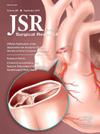Rectal Cancer Surgery and Survival in Asian American, Native Hawaiian, and Pacific Islander Patients
IF 1.7
3区 医学
Q2 SURGERY
引用次数: 0
Abstract
Introduction
Racial disparities in rectal cancer outcomes are well documented, yet Asian American, Native Hawaiian, and Pacific Islander (AANHPI) patients are often treated as a single group in research, obscuring subgroup differences. We examine variation in sphincter-preserving surgery (SPS)—which avoids a permanent ostomy when oncologically feasible—and survival among AANHPI subgroups.
Methods
We conducted a retrospective study using Surveillance, Epidemiology, and End Results data, identifying AANHPI patients with nonmetastatic rectal adenocarcinoma who underwent surgery (2007-2021). Racial subgroups were defined as East Asian, Native Hawaiian and other Pacific Islander (NHPI), Other Asian, South Asian, and Southeast Asian. Logistic regression was used to estimate odds of SPS, and Cox proportional hazards models assessed overall survival.
Results
Among 7989 patients, 87.1% underwent SPS and the 5-year observed overall survival was 81.4%. In fully adjusted models, NHPI patients had 42% lower odds of SPS (odds ratio: 0.58, 95% confidence interval: 0.46-0.74) and a 24% higher risk of mortality from any cause (hazard ratio 1.24, 95% confidence interval 1.04-1.48) compared to East Asian patients. Disparities in both outcomes were most pronounced in NHPI patients in higher-income counties. However, disparities in SPS were worse in NHPI patients with regional disease, compared to disparities in survival, which were worse in NHPI patients with localized disease.
Conclusions
Significant variation exists in rectal cancer treatment and survival across AANHPI subgroups, with NHPI patients facing the most pronounced disparities. These disparities were worse in higher-income counties, highlighting the need for further investigation into structural drivers of disparities affecting NHPI patients.
直肠癌手术与亚裔美国人、夏威夷原住民和太平洋岛民患者的生存率
种族差异在直肠癌预后方面有很好的文献记载,但在研究中,亚裔美国人、夏威夷原住民和太平洋岛民(AANHPI)患者经常被作为一个单一群体治疗,模糊了亚组差异。我们研究了保留括约肌手术(SPS)的变化-当肿瘤可行时避免永久性造口术-和AANHPI亚组的生存率。方法采用监测、流行病学和最终结果数据进行回顾性研究,确定2007-2021年接受手术的AANHPI非转移性直肠腺癌患者。种族亚群被定义为东亚人、夏威夷原住民和其他太平洋岛民(NHPI)、其他亚洲人、南亚人和东南亚人。采用Logistic回归估计SPS的几率,Cox比例风险模型评估总生存率。结果7989例患者中,87.1%接受了SPS治疗,5年观察总生存率为81.4%。在完全调整的模型中,与东亚患者相比,NHPI患者SPS的几率低42%(优势比:0.58,95%可信区间:0.46-0.74),任何原因导致的死亡风险高24%(风险比1.24,95%可信区间1.04-1.48)。两种结果的差异在高收入县的NHPI患者中最为明显。然而,区域性疾病的NHPI患者的SPS差异比局限性疾病的NHPI患者的生存差异更大。结论不同AANHPI亚组在直肠癌治疗和生存方面存在显著差异,其中NHPI患者差异最明显。这些差异在高收入县更严重,强调需要进一步调查影响NHPI患者的差异的结构性驱动因素。
本文章由计算机程序翻译,如有差异,请以英文原文为准。
求助全文
约1分钟内获得全文
求助全文
来源期刊
CiteScore
3.90
自引率
4.50%
发文量
627
审稿时长
138 days
期刊介绍:
The Journal of Surgical Research: Clinical and Laboratory Investigation publishes original articles concerned with clinical and laboratory investigations relevant to surgical practice and teaching. The journal emphasizes reports of clinical investigations or fundamental research bearing directly on surgical management that will be of general interest to a broad range of surgeons and surgical researchers. The articles presented need not have been the products of surgeons or of surgical laboratories.
The Journal of Surgical Research also features review articles and special articles relating to educational, research, or social issues of interest to the academic surgical community.

 求助内容:
求助内容: 应助结果提醒方式:
应助结果提醒方式:


